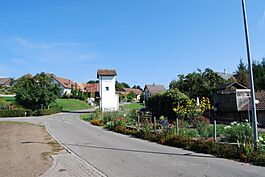Besenbüren facts for kids
Quick facts for kids
Besenbüren
|
||
|---|---|---|
 |
||
|
||
| Country | Switzerland | |
| Canton | Aargau | |
| District | Muri | |
| Area | ||
| • Total | 2.38 km2 (0.92 sq mi) | |
| Elevation | 455 m (1,493 ft) | |
| Population
(Dec 2020 )
|
||
| • Total | 632 | |
| • Density | 265.5/km2 (687.8/sq mi) | |
| Postal code |
5627
|
|
| Surrounded by | Aristau, Boswil, Bünzen, Hermetschwil-Staffeln, Rottenschwil | |
Besenbüren is a small town, also called a municipality, located in the Muri district of the canton of Aargau in Switzerland. It's a quiet place with a rich history and a close-knit community.
Contents
History of Besenbüren
The very first signs of people living near Besenbüren are ancient tools from the Paleolithic (Old Stone Age) and Mesolithic (Middle Stone Age) periods. These were found in an area called Forenmoos.
Besenbüren itself was first mentioned in a very old document called the Acta Murensia. This document was put together around the year 1160, but it included even older records.
During the Middle Ages (a long time ago, from about the 5th to the 15th century), the main landowners in Besenbüren were two important monasteries: Muri and Engelberg Abbey.
For a while, Besenbüren was part of the Muri district under the rule of the Habsburgs, a powerful European family. After the year 1415, when the Old Swiss Confederacy (the early form of Switzerland) took over the Aargau region, Besenbüren became part of the Boswil district.
In the 1800s, most people in Besenbüren worked in farming or in the straw plaiting industry, which involved weaving straw into things like hats. The town's population actually went down in the late 1800s because of fires, people moving away, and not enough land. Because it was hard to get to and was quite small, Besenbüren didn't develop much industry. However, by 1990, the service industry (like shops and offices) had become the biggest employer.
Geography of Besenbüren
Besenbüren covers an area of about 2.38 square kilometers (about 0.92 square miles). A big part of this land, about 66.4%, is used for farming. Forests cover about 19.7% of the area. The rest of the land, about 12.2%, has buildings or roads on it.
Most of the farming land is used for growing crops. The municipality is located on the western edge of a ridge called the Wagenrain. Besenbüren itself is the main village within the municipality.
Besenbüren's Coat of Arms
The coat of arms for Besenbüren has a special description called a blazon. It shows a birch tree growing from a green, jagged hill. On either side of the tree are two cranberry blossoms. The background color is gold.
People of Besenbüren (Demographics)
Besenbüren has a population of about 600 people. A small part of the population, about 5.9%, are people from other countries. Over the past ten years, the number of people living here has grown quite a bit.
Most people in Besenbüren speak German, which is about 97.2% of the population. A few people also speak English or Finnish.
Looking at the age groups, about 15.5% of the population are children aged 0 to 9 years old. Teenagers aged 10 to 19 make up about 13.1%. The largest group is adults aged 40 to 49, making up 23% of the population.
In 2000, the average home in Besenbüren had about 2.7 people living in it. Most homes, about 66.1%, were owned by the people living in them, meaning they didn't pay rent.
In the 2007 federal election, the most popular political party was the SVP, which received about 46.8% of the votes. Other popular parties included the CVP and the SP.
Here's how the population of Besenbüren has changed over time:
| Historical population | ||
|---|---|---|
| Year | Pop. | ±% |
| 1850 | 417 | — |
| 1900 | 289 | −30.7% |
| 1950 | 322 | +11.4% |
| 1980 | 280 | −13.0% |
| 2000 | 496 | +77.1% |
Important Buildings
A building called the Speicher (which means warehouse) on Zentralstrasse is very important. It is listed as a Swiss heritage site of national significance. This means it's a special building protected for its historical or cultural value.
Economy of Besenbüren
In 2007, the unemployment rate in Besenbüren was quite low, at 1.5%. This means very few people who wanted jobs couldn't find them.
In 2005, many people worked in the primary economic sector, which includes farming. Fewer people worked in the secondary sector (like manufacturing) or the tertiary sector (like services).
Most people who live in Besenbüren actually work outside the municipality. Only a small number of people travel into Besenbüren for work. Many people use a private car to get to work, while a smaller number use public transportation.
Religion in Besenbüren
According to a census in 2000, most people in Besenbüren are Roman Catholic, making up about 55.8% of the population. About 26.8% belong to the Swiss Reformed Church.
Education in Besenbüren
Switzerland is known for its good education system. In Besenbüren, about 76.6% of adults (aged 25–64) have completed higher education, like university or a specialized college.
In the 2008/2009 school year, there were 58 students attending primary school in Besenbüren.
See also
 In Spanish: Besenbüren para niños
In Spanish: Besenbüren para niños




